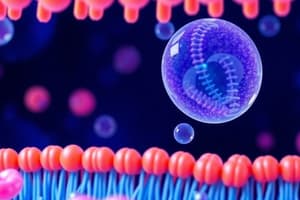Podcast
Questions and Answers
What is a major cause of the size limits for certain types of cells?
What is a major cause of the size limits for certain types of cells?
The need for a surface area of sufficient area to allow the cell's function.
What is the function of Structure E?
What is the function of Structure E?
Stabilization of the phospholipids.
Identify Structure D.
Identify Structure D.
Phospholipid bilayer of membrane.
Identify Structure A.
Identify Structure A.
Why do unsaturated fatty acids help keep any membrane more fluid at lower temperatures?
Why do unsaturated fatty acids help keep any membrane more fluid at lower temperatures?
What is the most important function for the glycoproteins and glycolipids of animal cell membranes?
What is the most important function for the glycoproteins and glycolipids of animal cell membranes?
What is true of the evolution of cell membranes?
What is true of the evolution of cell membranes?
What name is given to the process shown in this animation?
What name is given to the process shown in this animation?
Structure A in this animation is a(n) _____.
Structure A in this animation is a(n) _____.
Which of these cannot rapidly pass directly through the phospholipids of the plasma membrane?
Which of these cannot rapidly pass directly through the phospholipids of the plasma membrane?
Why does water pass quickly through cell membranes?
Why does water pass quickly through cell membranes?
Which factor does not affect membrane permeability?
Which factor does not affect membrane permeability?
How can a lipid be distinguished from a sugar?
How can a lipid be distinguished from a sugar?
Osmosis is a type of diffusion.
Osmosis is a type of diffusion.
What property of dishwashing liquid (detergent) makes it useful to wash grease from pans?
What property of dishwashing liquid (detergent) makes it useful to wash grease from pans?
Which particles could diffuse easily through a cell membrane?
Which particles could diffuse easily through a cell membrane?
The water-soluble portion of a phospholipid is the polar head, which generally consists of a glycerol molecule linked to a phosphate group.
The water-soluble portion of a phospholipid is the polar head, which generally consists of a glycerol molecule linked to a phosphate group.
If a red blood cell is placed in a salt solution and bursts, what is the tonicity of the solution relative to the interior of the cell?
If a red blood cell is placed in a salt solution and bursts, what is the tonicity of the solution relative to the interior of the cell?
Flashcards are hidden until you start studying
Study Notes
Size Limits of Cells
- Size limits in cells are primarily due to the necessity for adequate surface area to facilitate their functions.
Role of Cholesterol
- Cholesterol stabilizes the plasma membrane's structure, maintaining its integrity.
Phospholipid Bilayer
- The phospholipid bilayer forms the membrane structure, characterized by a phosphate head and two fatty acid tails.
Glycoproteins
- Glycoproteins, composed of carbohydrates and proteins, play essential roles in cell recognition and interaction.
Fluidity of Membranes
- Unsaturated fatty acids enhance membrane fluidity at lower temperatures due to double bonds creating kinks in the fatty acid tails, increasing separation between adjacent lipids.
Distinction Between Cells
- Glycoproteins and glycolipids are crucial for a cell's ability to differentiate and recognize neighboring cells.
Evolution of Membranes
- Over time, cell membrane properties are subject to selection pressures as organisms evolve.
Diffusion Process
- Diffusion refers to the movement of particles from areas of higher concentration to lower concentration, which is a fundamental cellular process.
Transport Proteins
- Transport proteins facilitate the entry of solute molecules into cells, crucial for nutrient uptake.
Membrane Permeability
- Water, glucose, and hydrogen ions do not pass easily through phospholipid bilayers and require specialized transport proteins for movement.
Aquaporins
- Water molecules traverse cell membranes rapidly via aquaporins, which are protein channels specifically designed for water transport.
Factors Affecting Membrane Permeability
- The polarity of membrane phospholipids does not influence membrane permeability; rather, their structure enables bilayer formation essential for membrane integrity.
Distinguishing Lipids from Sugars
- Lipids are predominantly nonpolar molecules, distinguishing them from polar sugars.
Osmosis as Diffusion
- Osmosis, the diffusion of water across a selectively permeable membrane, is classified as a type of diffusion.
Detergents and Grease Removal
- Detergents possess an amphipathic nature, allowing them to encase grease in micelles for effective cleaning.
Diffusion of Small Molecules
- Small nonpolar molecules like oxygen can diffuse readily across cell membranes due to their size and polarity.
Structure of Phospholipids
- A phospholipid's hydrophilic head, mainly composed of glycerol with a phosphate group, is soluble in water, contrasting with its hydrophobic tail.
Tonicity and Cell Behavior
- A red blood cell placed in a hypotonic solution experiences water influx, leading to potential bursting due to osmotic pressure differentials.
Studying That Suits You
Use AI to generate personalized quizzes and flashcards to suit your learning preferences.




